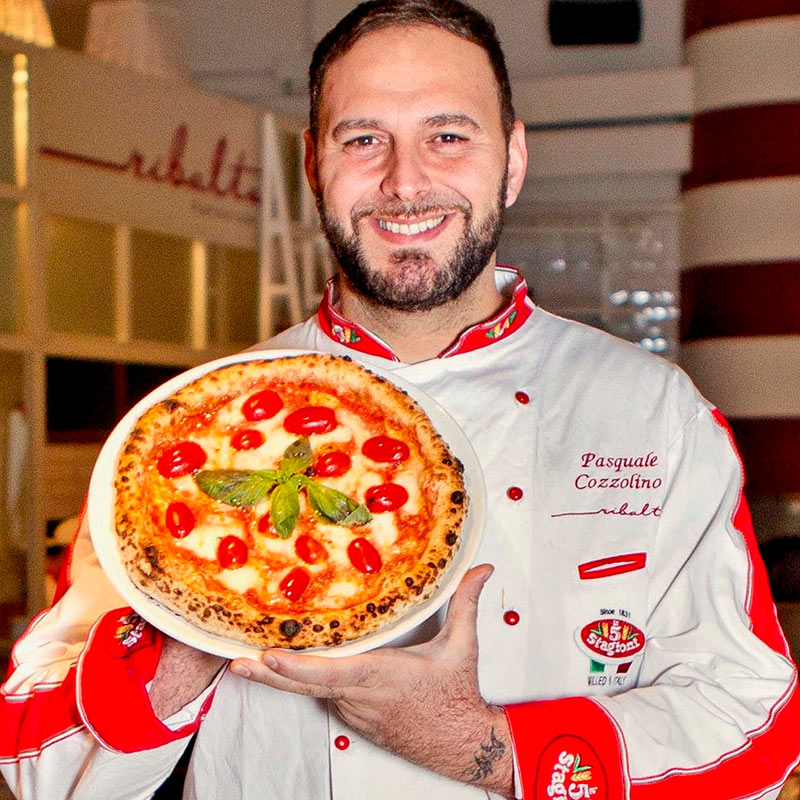Welcome, log on to see the site
Welcome, log on to see the site


The first quality criterion of a good pizza is its appearance: it should have the black spots of a leopard.
An even shape is not mandatory. It should have the classic freshly-baked bread smell and the pizza should be light and airy. Pizzas vary enormously throughout the world, ranging from the highly standardised, industrially-made pizza at one end of the spectrum through to the more irregularly shaped, so-called «artisanal» versions at the other.
But make no mistake: a pizza is not just a bit of bread with tomato paste on top!
For me, the original pizza is the Neapolitan, created and invented in Naples. The Pizza Napoletana is based on a simple dough recipe, simple ingredients, long fermentation, 60/65% water, no chemical ingredients, and starts with a yeast-based fermentation. The Roman and Sicilian style pizzas, for example, were created in the United States and then spread all around the world.
In 2004, the first Neapolitan pizzeria was founded in the United States, but it wasn’t such a great success. In 2008, a second attempt was made, this time it was a big hit. It marked the beginning of a wave of Neapolitan pizzerias that were about to take the American market by storm. When I arrived in the United States in 2011, I brought with me two pizza recipes, which nobody had ever heard of on that side of the Atlantic: the «fried pizza», known back then as the Montanara, and the Pala (one of my own creations).
The Montanara is made using the same dough as the Neapolitan pizza, but it is deep-fried and topped with a tomato sauce and pecorino cheese, then baked in a wood fire oven in order to «dry out» the oil. The Pala, however, differs from the Napoletana in terms of the water content : 78% for the Pala compared with 60/65% for the Napoletana, which means you have to bake it at a low temperature for the water to evaporate. The Pala also has a special ingredient: extra virgin olive oil. When water evaporates during baking, the oil content helps to preserve the moisture in the dough. It is the oil that makes the pizza soft inside and extra crispy on the outside.
How to make a good pizza? Firstly it requires simple, good quality ingredients: for me that means flour, salt, water and yeast (natural, or brewer’s yeast). Then, the fermentation phase is extremely important; minimum 24h and temperature-controlled. If the fermentation phase lasts only 3/4h, the gluten will not be completely broken down, making the pizza less digestible. Personally speaking, I use 48h fermentation to optimise the digestibility of my own pizzas; a pizza Napoletana generally requires 12h fermentation.
For mixing, you will need a mixer that allows for maximum water absorption by the dough. Last of all, baking is very important; it’s better to bake it in a wood fire oven. In short, a pizza maker should know his job to keep his customers coming back for more. For instance, he should be able to reassure customers with his knowledge of top-quality ingredients, appropriate length of fermentation, etc.
In my restaurants, customers thought the pizza Napoletana was too soft and soggy! But then I explained that the original pizza was like that, baked at a low temperature to keep the moisture inside the dough, and that the soft texture originally meant you could fold the pizza and eat it while walking along. Not exactly soggy, but certainly juicy, because it contained fresh mozzarella, which is high in fat (compared to other lower-fat cheeses, etc.), as well as a freshly made tomato sauce.
The pizza Napoletana is nowadays regarded as a «healthy» pizza, you can even treat yourself to a glass of wine with it.
The United States turned out to be the perfect trial territory for the pizza Napoletana, given the diverse backgrounds of consumers. Americans came to love it, once they accepted the «moist» texture, but it’s also popular with Asians, Indians, the French and of course southern Italians (Italians from the north prefer it crunchier, but it’s no”t really an issue, because if you bake it a bit longer, you can get a crispier texture anyway). In other words, everyone loves pizza!
Pascale Cozzolino, Executive Chef at Ribalata, USA